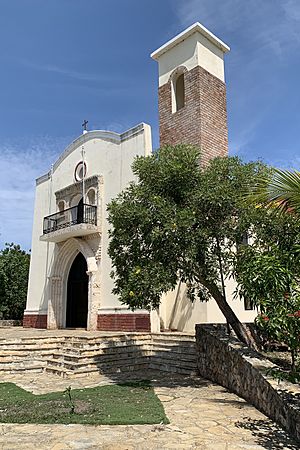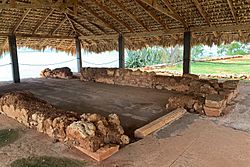La Isabela facts for kids
La Isabela was the very first permanent Spanish town in the Americas. It was founded in December 1493 in the Puerto Plata Province of the Dominican Republic. You can find it about 42 kilometers (26 miles) west of the city of Puerto Plata, right next to a village called El Castillo. Today, this area is a National Historic Park.
Christopher Columbus started La Isabela during his second trip to the New World. He named it after Queen Isabella I of Castile from Spain. A year before, Columbus had set up a small settlement called La Navidad in what is now Haiti. But the native Taíno people destroyed it before he came back. By the year 1500, La Isabela was also abandoned. The only European settlements before this were by the Vikings in Greenland and Newfoundland, about 500 years earlier.
La Isabela was built because the Spanish wanted to find valuable metals like gold. However, the settlement faced many challenges. It was hit by the first known sickness (epidemic) that spread from Europe to the New World in 1493. It also experienced two of the earliest North Atlantic hurricanes ever seen by Europeans, in 1494 and 1495.
Because of hunger and sickness, some settlers, led by Bernal de Pisa, tried to take ships and go back to Spain. This was a mutiny (a rebellion against authority). La Isabela barely survived until 1496. That's when Columbus decided to leave it for a new settlement. This new place was founded in 1498 and was first called Nueva Isabela. It was soon renamed Santo Domingo, which is still an important city today.
Contents
Building the Colony
After his first journey to the New World, Columbus returned to Hispaniola with seventeen ships. His settlers quickly built homes, storage buildings, a Roman Catholic church, and a large house for Columbus himself. More than a thousand men came with him. These included sailors, soldiers, carpenters, stonemasons, and other workers. Priests and nobles also joined them.
The Spanish brought pigs, horses, wheat, sugarcane, and guns. Unfortunately, rats and tiny germs (microbes) came too. These germs caused the first influenza epidemic in the Americas. The whole settlement covered more than two hectares (about five acres).
The very first Mass (a Christian church service) was held in La Isabela on January 6, 1494. The town had about 200 huts made of thatch, a central plaza, and Columbus's stone house and a place to store weapons.
Life with the Taíno People
The Taíno people were the native inhabitants living in the mountains near La Isabela. They ate fish and important foods like pineapple, which they shared with the Spanish. The food they provided was very important for the Spanish settlers. Columbus himself said that there were no finer people in the world than the Taíno.
In March 1494, Columbus's men started looking for gold in the mountains of Hispaniola. They searched with the help of the Taíno Indians, and they found small amounts of gold.
Facing Nature's Fury
In June 1495, a huge storm hit the island. The Taíno people called this storm a hurricane. The Taíno went to the mountains to find shelter, but the Spanish stayed in the colony. Several ships were sunk by the storm, including Columbus's main ship, the Marie-Galante.
Today, old cannon barrels and anchors from that time have been found in the bay. Over many years, mud from rivers and ocean waves have raised the bottom of the bay. This covers any parts of the old shipwrecks that might still be there.
There are also caves on the island where the Taíno Indians might have hidden during storms. These caves have pictures drawn on their walls. These pictures show the sun, plants, animals, strange shapes, people, bearded faces, and even sailing ships.
Challenges and Changes
Christopher Columbus left La Isabela from April 24 to September 29, 1494. During this time, he explored Cuba and also discovered Jamaica. He left his brother, Diego Columbus, in charge of the island.
While Christopher was away, his other brother, Bartholomew Columbus, arrived. The Taíno people also started a revolt (a rebellion). Captain Pedro Margarit, one of the Spanish leaders, even fled back to Spain.
On March 24, 1495, Christopher Columbus, with the help of a friendly Taíno leader named Guacanagari, marched against other Taíno chiefs. He had 200 men, 20 horses, and 20 hunting dogs. He captured or killed many, including a main chief named Caonabo. Caonabo was responsible for the attack on the La Navidad settlement earlier. He was sent to Spain as a prisoner.
By this time, only 630 Christians were left in La Isabela. Many of them were sick, and there were many children and women. Christopher Columbus himself left for Spain on March 10, 1496. He took 225 Christians and 30 Taíno Indians with him on two ships, the Santa Cruz and the Nina. By then, the native Taínos were suffering greatly from a lack of food and many diseases. Their numbers had dropped by two-thirds.
Abandoning La Isabela
Within a year of Christopher Columbus leaving, the settlers in La Isabela faced more problems. Their food was running low, and sickness continued to spread. They became unhappy and lost hope for the future.
The mayor, Francisco Roldán, started a secret group. He didn't want to be ruled by a foreigner (Columbus's brothers). He planned to kill Christopher's brothers, Bartholomew and Diego. Roldán and his rebels eventually moved to Xaragua, a place with fertile land.
When Christopher Columbus returned to Santo Domingo on August 30, 1498, he found many people he had left behind were dead. About 160 were sick, and many more had joined Roldán's rebellion. This rebellion lasted for two years. It finally ended on August 3, 1499. Christopher agreed to let Roldán keep his job as mayor. He also allowed 15 rebels to return to Spain and gave houses and land to those who stayed. He publicly announced that everything that happened was caused by false stories from a few bad people.
In 1499, gold was discovered in the central mountains (the cordillera central). This led to a gold mining boom. Because of this, most people left La Isabela by the year 1500 to go to the new gold areas. This is why La Isabela became empty and was abandoned.
See also
 In Spanish: La Isabela para niños
In Spanish: La Isabela para niños










